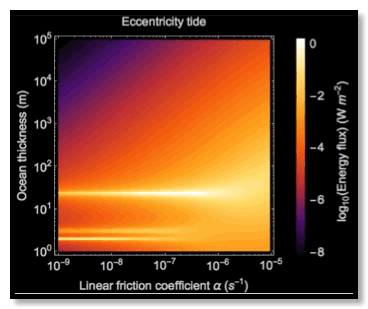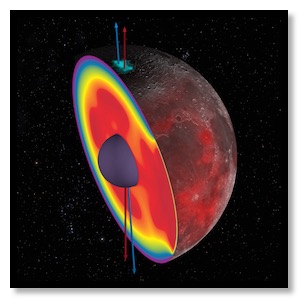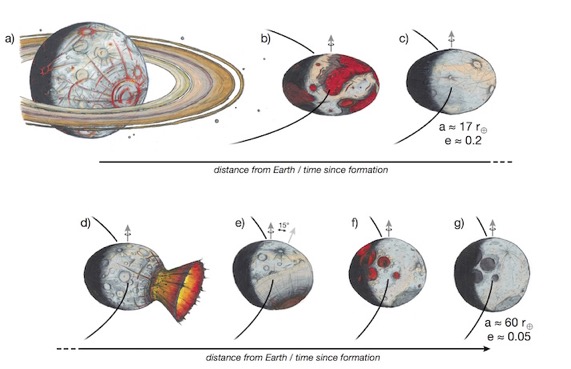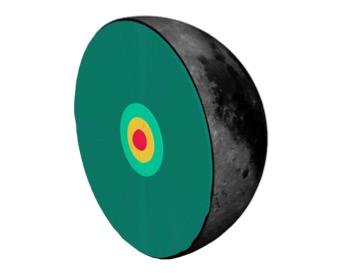Tidal heating in the oceans of icy satellites
22/07/21 14:20

There is a pressing need for the community to develop models of ocean tidal heating that take into account the effect of a solid lid on ocean dynamics. This is important for Enceladus, Titan, Europa, Ganymede and Callisto given that each of them is likely characterized by a ∼10 − 100 km thick solid shell overlying an ocean layer. An additional topic not yet addressed within the icy satellite community is how a non-global or variable thickness subsurface ocean would affect tidal heating. Enceladus likely falls into this category since extensive resurfacing is limited to its South Polar Terrain, which is also characterized by a large thermal anomaly. Tidal heating is thought to be the main source of this heat signature. NASA’s Cassini spacecraft obtained measurements of this surface heat flux, and these data can, in principle, be used to constrain ocean thickness. However, in order to explore this connection, it is necessary to consider heating in a variable thickness subsurface ocean, a task that can only be performed numerically. I am currently supervising a graduate student (Hamish Hay) to work on this ambitious problem.
Relevant publications:
- Downey, B. G., Nimmo, F. & Matsuyama, I. Inclination damping on Callisto. Monthly Notices of the Royal Astronomical Society 499, 40–51 (2020).
- Hay, H., Trinh, A. & Matsuyama, I. Powering the Galilean Satellites with Moon‐moon Tides. Geophys. Res. Lett. 47, (2020).
- Hay, H. C. F. C. & Matsuyama, I. Tides Between the TRAPPIST-1 Planets. The Astrophysical Journal 875, 22 (2019).
- Hay, H. C. F. C. & Matsuyama, I. Nonlinear tidal dissipation in the subsurface oceans of Enceladus and other icy satellites. Icarus 319, 68–85 (2019).
- Matsuyama, I., Beuthe, M., Hay, H. C. F. C., Nimmo, F. & Kamata, S. Ocean tidal heating in icy satellites with solid shells. Icarus 312, 208–230 (2018).
- Hay, H. C. F. C. & Matsuyama, I. Numerically modelling tidal dissipation with bottom drag in the oceans of Titan and Enceladus. Icarus 281, 342–356 (2017).
- Matsuyama, I. Tidal dissipation in the oceans of icy satellites. Icarus 242, 11–18 (2014).
Rotational stability of planets
22/07/21 14:19

The spin axis orientation of planetary bodies can change due to a variety of processes such as internal convection, glaciation or impacts. Mass redistribution associated with these processes perturbs the inertia tensor of the planet, forcing it to reorient to a new minimum rotational energy state. This reorientation is commonly referred to as true polar wander (TPW) and manifestations of it provide constraints on the interior structure of planetary bodies. Despite their diversity, many solar system bodies appear to have undergone reorientation, underlying the universality of the physical processes driving TPW. I have developed new theoretical treatments for investigating TPW that take into account a suite of previously ignored driving mechanisms. These theoretical formulations are sufficiently general to provide the foundation of any future study of TPW and I have led in their application to a diverse set of planetary studies. Image credit: James Keane.
Relevant publications:
- Matsuyama, I., Nimmo, F., & Mitrovica, J. X. (2014). Planetary Reorientation. Annual Review of Earth and Planetary Sciences, 42, 605–634. http://doi.org/10.1146/annurev-earth-060313-054724
- Bouley, S., Baratoux, D., Matsuyama, I., Forget, F., Séjourné, A., Turbet, M., & Costard, F. (2016). Late Tharsis formation and implications for early Mars. Nature, 531, 344–347. http://doi.org/10.1038/nature17171
- Siegler, M. A., Miller, R. S., Keane, J. T., Laneuville, M., Paige, D. A., Matsuyama, I., et al. (2016). Lunar true polar wander inferred from polar hydrogen. Nature, 531, 480–484. http://doi.org/10.1038/nature17166
Fossil figure of the Moon
22/07/21 14:15

It has been known for centuries that the lunar rotational and tidal bulges are much larger than expected. The excess deformation is thought to arise due to a fossil figure established when the Moon orbited much closer to Earth than it does today. However, previous investigations of this possibility assumed infinite material rigidity after the fossil figure was established, which precludes the application of the approach to investigations of planetary bodies. To remedy this, I developed a generalized model characterized by finite rigidity, and demonstrated, in application to the Moon, that an interior with a rigidity typical of rocks can preserve a fossil figure capable of explaining the present rotational and tidal bulges (Matsuyama, 2013). However, explaining the observed figure also required an initially highly eccentric or non-synchronous orbit, contrary to current views of lunar formation and evolution. In a subsequent paper, my graduate student (James Keane) and I investigated whether impact basins, volcanic plains, and other lunar gravity anomalies could contribute to the observed excess deformation (Keane and Matsuyama 2014). We found that a single impact basin—the giant South Pole-Aitken basin—could explain a large fraction of the excess deformation. Accounting for the signal associated with this basin, we found that the lunar fossil figure was consistent with a low-eccentricity, synchronous orbit. Image credit: James Keane.
Relevant publications:
- Keane, J. T., & Matsuyama, I. (2014). Evidence for Lunar True Polar Wander, and a Past Low-Eccentricity, Synchronous Lunar Orbit. Geophysical Research Letters, 41. http://doi.org/10.1002/2014GL061195
- Matsuyama, I. (2013). Fossil figure contribution to the lunar figure. Icarus, 1–4. doi:10.1016/j.icarus.2012.10.025
Constraining the deep interior structure of the Moon
22/07/21 14:12

Planetary interior structure models suffer from an inherent non-uniqueness. However, it is possible to better constrain parameters governing the interior structure using available observational constraints. For the Moon, these constraints are derived from seismic measurements, lunar laser ranging, and magnetic and gravity observations. Following up on previous suggestions of partial melting at the bottom of the Lunar mantle based on early seismic data analyses, recent studies have argued for the presence of a low rigidity layer between the liquid outer core and the mantle. As a participating scientist with NASA’s GRAIL mission, I constrained the interior structure by solving the inverse problem using the observed mass, moment of inertia, and Love numbers. The work provides rigorous measures of uncertainty and resolving power, and indicates that a low rigidity layer between the liquid outer core and mantle is not favored by current observations.
Relevant publications:
- Matsuyama, I., Nimmo, F., Keane, J. T., Chan, N. H., Taylor, G. J., et al. (2016). GRAIL, LLR, and LOLA constraints on the interior structure of the Moon. Geophysical Research Letters, 1–11. http://doi.org/10.1002/2016GL069952
